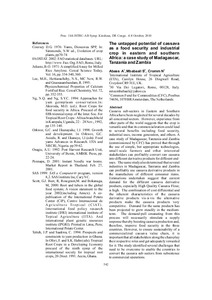| dc.contributor.author | Abass, A. |
| dc.contributor.author | Mbabaali, S. |
| dc.contributor.author | Cromme, N. |
| dc.date.accessioned | 2019-12-04T11:07:58Z |
| dc.date.available | 2019-12-04T11:07:58Z |
| dc.date.issued | 2012-02 |
| dc.identifier.citation | Abass, A., Mbabaali, S. & Cromm, N. (2012). The untapped potential of cassava as a food security and industrial crop in eastern and southern Africa: a case study of Madagascar, Tanzania and Zambia. In: Proceedings of the 11th triennial Symposium of the ISTRC-AB held at Memling Hotel: Tropical roots and tuber crops and the challenges of globalization and climate changes, (pp. 542-548), 4-8 October, Kinshasa, Democratic Republic of Congo. |
| dc.identifier.uri | https://hdl.handle.net/20.500.12478/1676 |
| dc.description.abstract | Cassava sub-sectors in Eastern and Southern Africa have been neglected for several decades by all concerned sectors. However, experience from other parts of the world suggests that the crop is versatile and that its commercialization could lead
to several benefits including food security, industrial uses, income generation, and others. A case study of Madagascar, Tanzania and Zambia (commissioned by CFC) has proved that through the use of simple, but appropriate technologies, small-scale farmers and other interested stakeholders can profitably convert raw cassava into different derivative products for different enduses. The same study also determined that several industries in Madagascar, Tanzania and Zambia can profitably use cassava derivative products in the manufacture of different consumer items. Estimations undertaken suggest that current
demand for the different cassava derivative products, especially High Quality Cassava Flour, is high. The combination of cost differential and the inherent characteristics of the cassava derivative products vis-à-vis the alternative products make the cassava products very competitive. Demand for the same products has been projected to grow steadily in the medium term.
The demand-pull emanating from this process will necessarily stimulate a supply response thereby boosting cassava production and, therefore, improve food security in the three countries. However, to ensure sustainability of a commercialized cassava value chain, it is important that all stakeholders along the chain play their respective roles and get adequately rewarded for it. The study identified several challenges that need to be overcome to enable the countries to convert the cassava sub-sectors from subsistence to commercial operations. |
| dc.format.extent | 542-548 |
| dc.language.iso | en |
| dc.publisher | International Society For Tropical Root Crops-Africa Branch |
| dc.subject | Cassava |
| dc.subject | Food Security |
| dc.subject | Income Generation |
| dc.subject | Industrial Uses |
| dc.subject | Hqcf |
| dc.subject | Cassava Derivative Products |
| dc.subject | Income Security |
| dc.title | The untapped potential of cassava as a food security and industrial crop in eastern and southern Africa: a case study of Madagascar, Tanzania and Zambia |
| dc.type | Conference Proceedings |
| dc.description.version | Peer Review |
| cg.contributor.crp | Roots, Tubers and Bananas |
| cg.contributor.affiliation | International Institute of Tropical Agriculture |
| cg.contributor.affiliation | Common Fund for Commodities |
| cg.coverage.region | Africa |
| cg.coverage.region | East Africa |
| cg.coverage.region | Southern Africa |
| cg.coverage.country | Madagascar |
| cg.coverage.country | Tanzania |
| cg.coverage.country | Zambia |
| cg.authorship.types | CGIAR and advanced research institute |
| cg.iitasubject | Agribusiness |
| cg.iitasubject | Cassava |
| cg.iitasubject | Food Security |
| cg.iitasubject | Land Use |
| cg.iitasubject | Value Chains |
| cg.howpublished | Formally Published |
| cg.publicationplace | Ibadan, Nigeria |
| cg.accessibilitystatus | Limited Access |
| local.dspaceid | 82848 |
| cg.targetaudience | Scientists |

